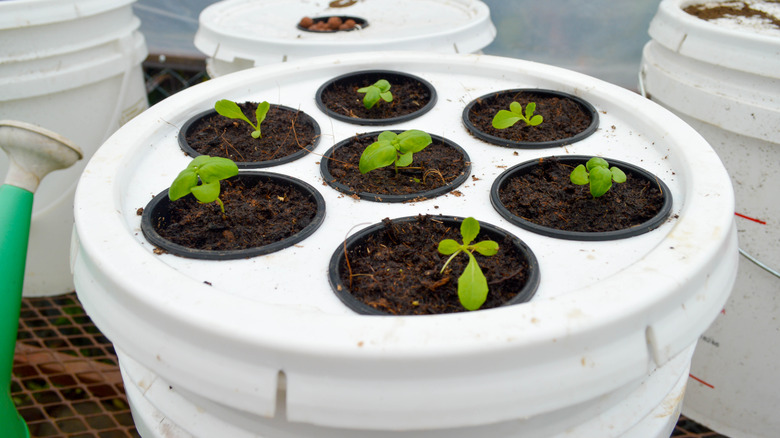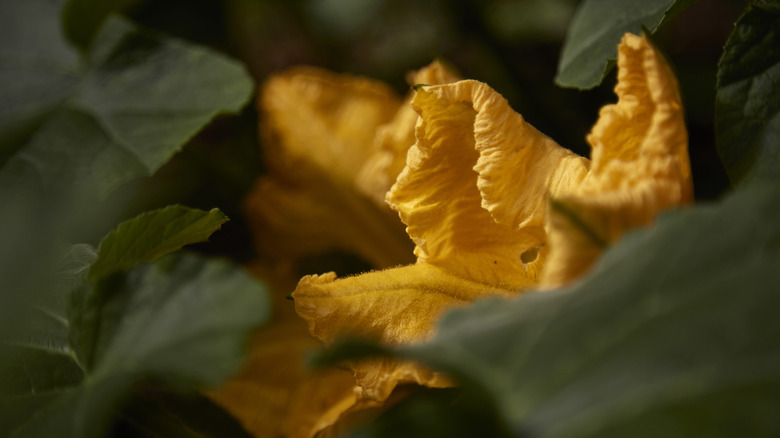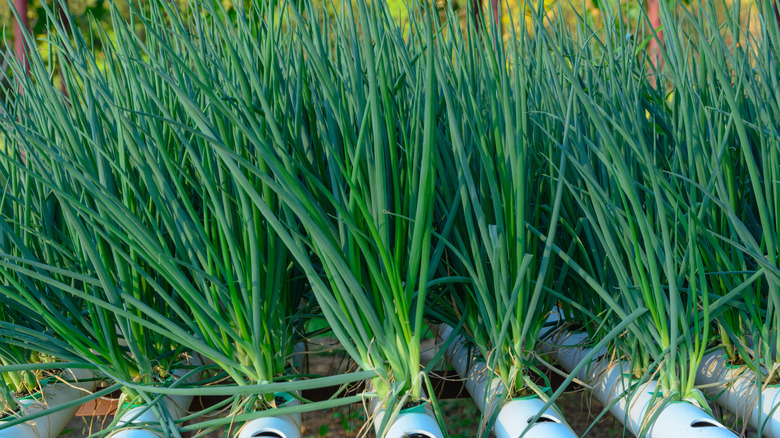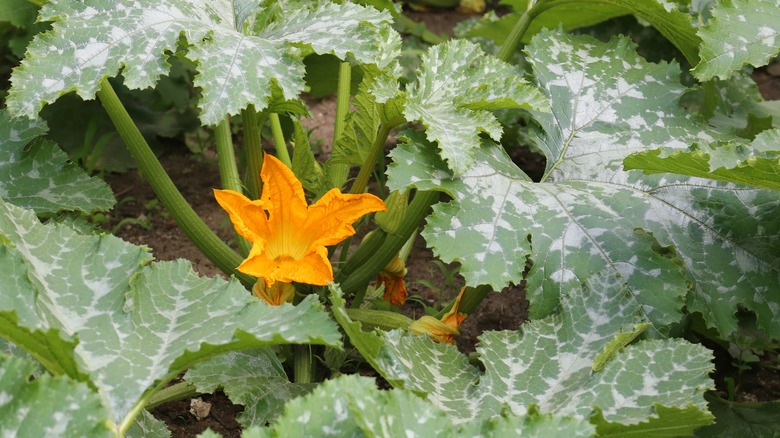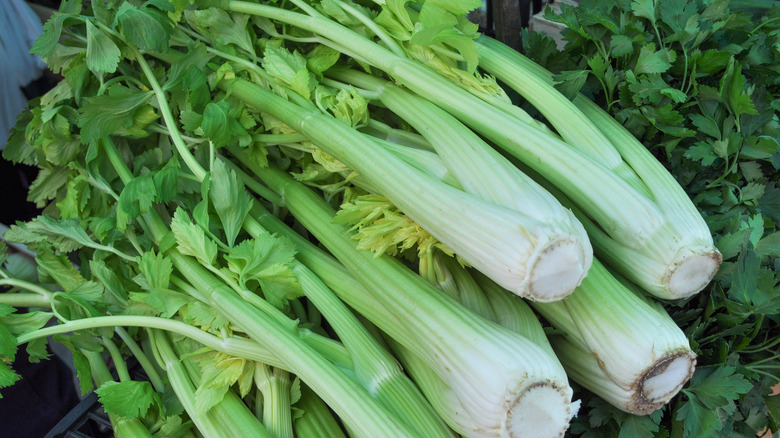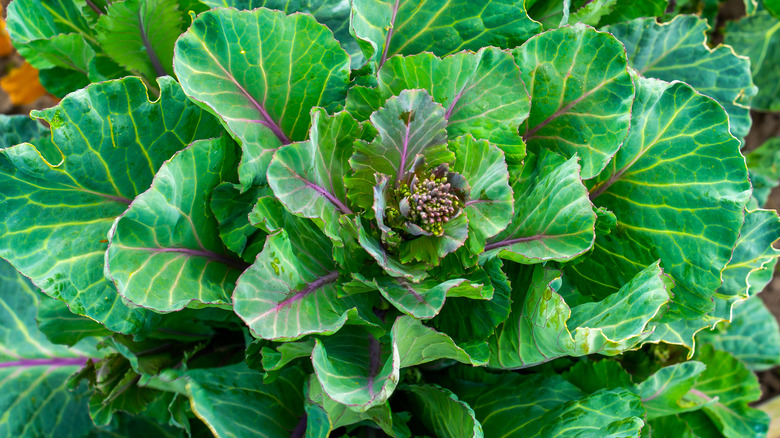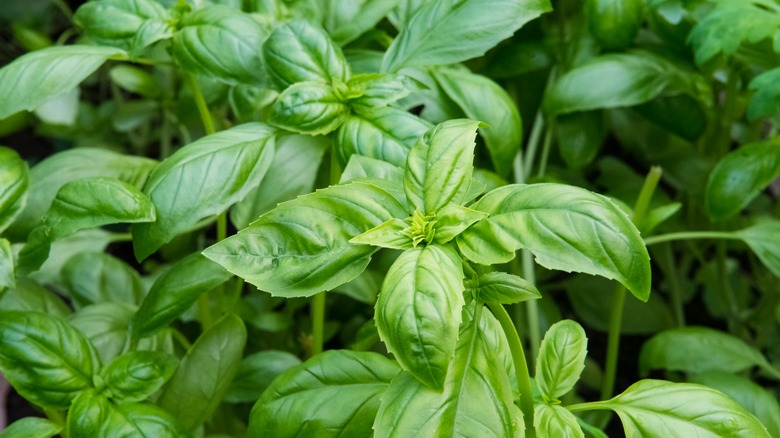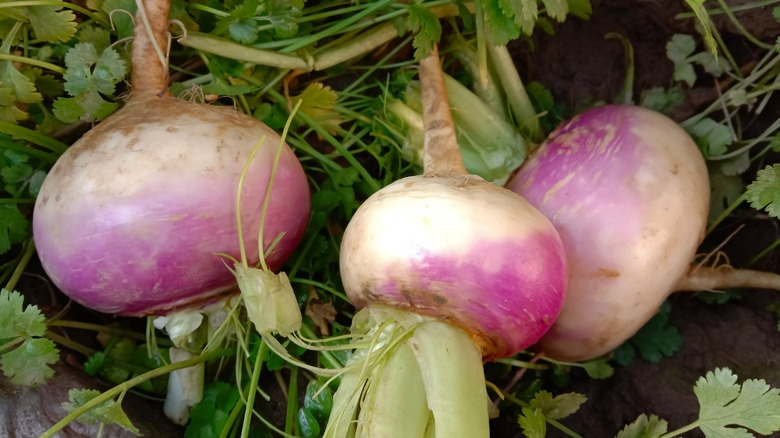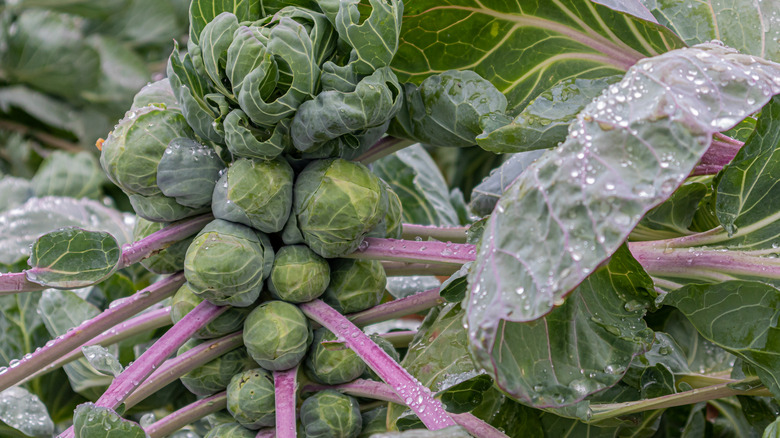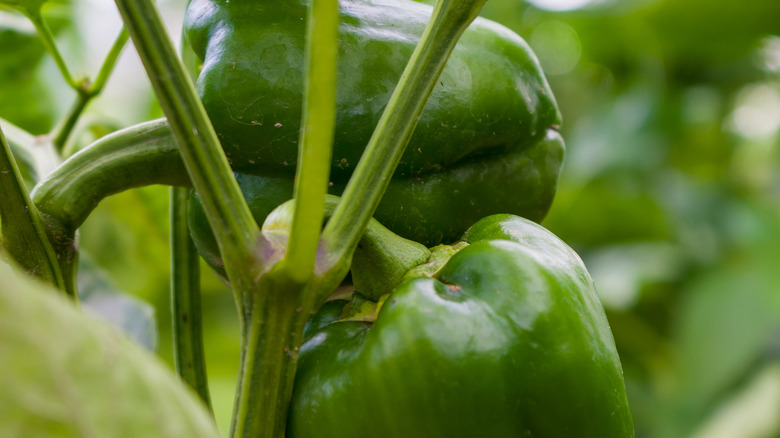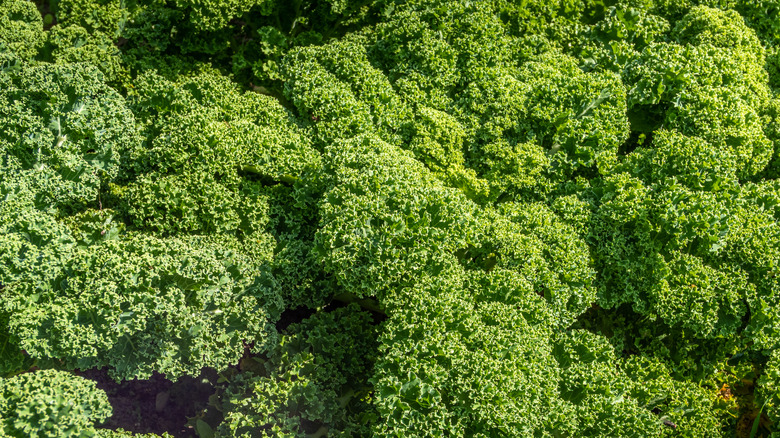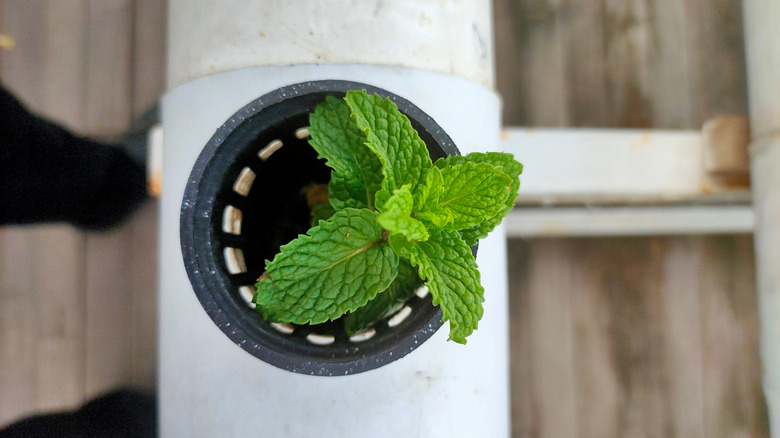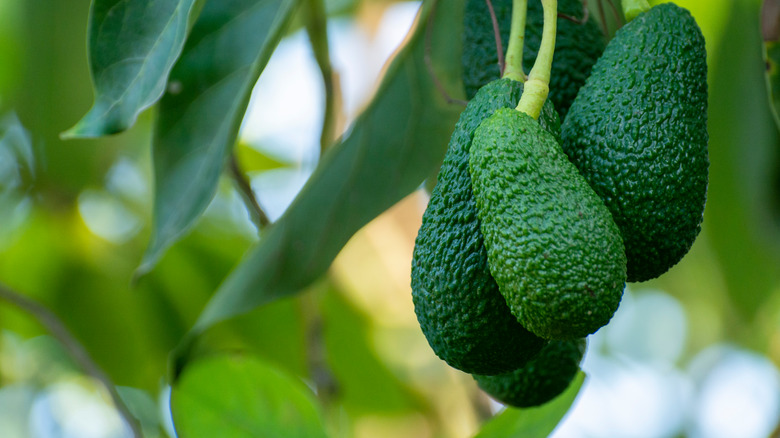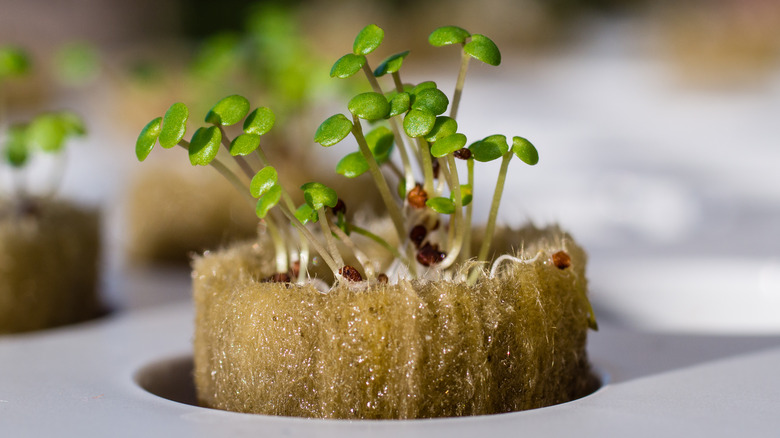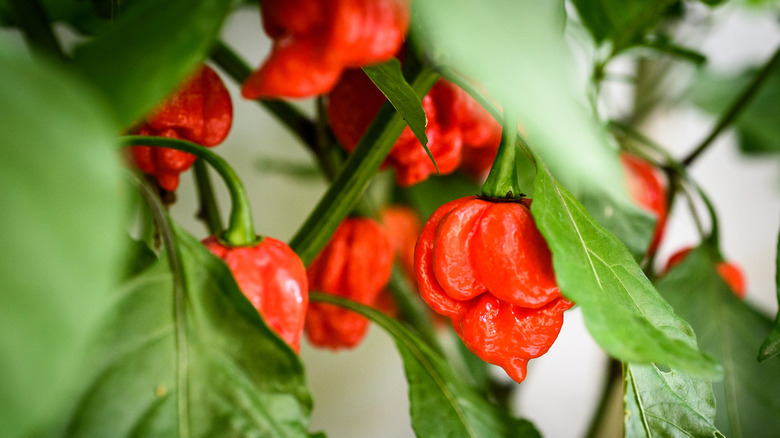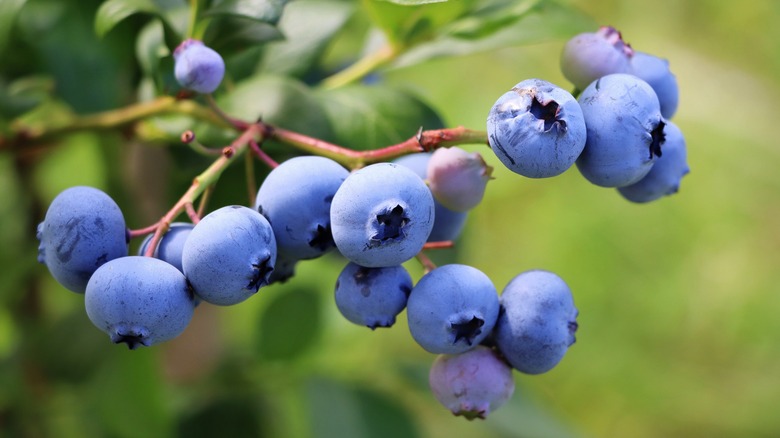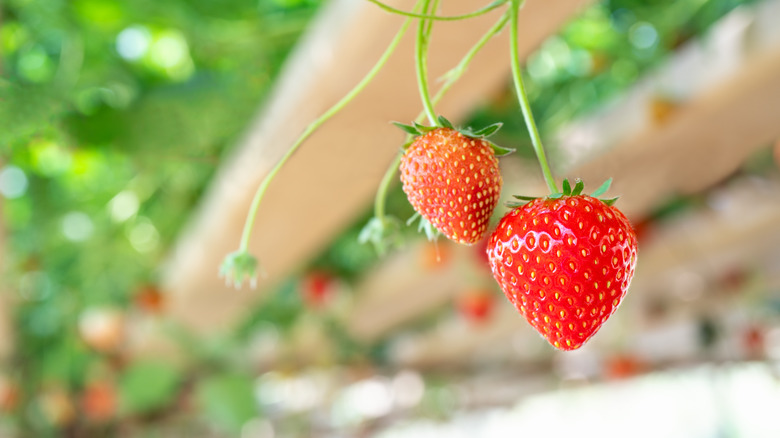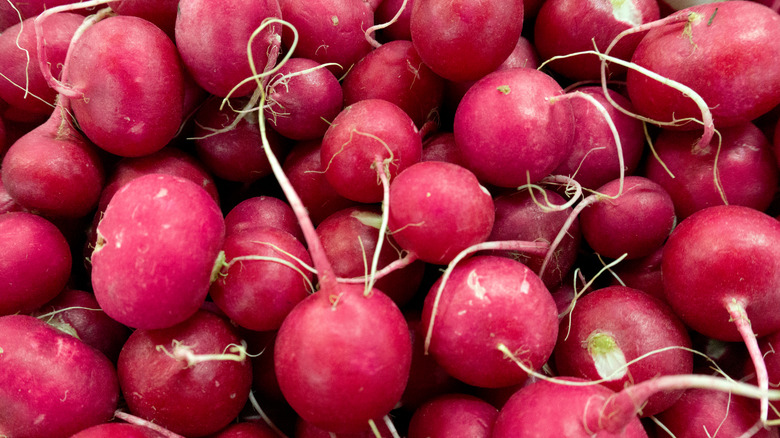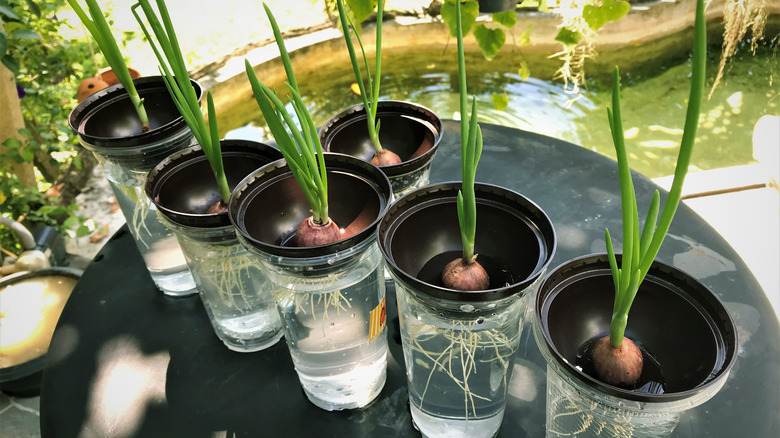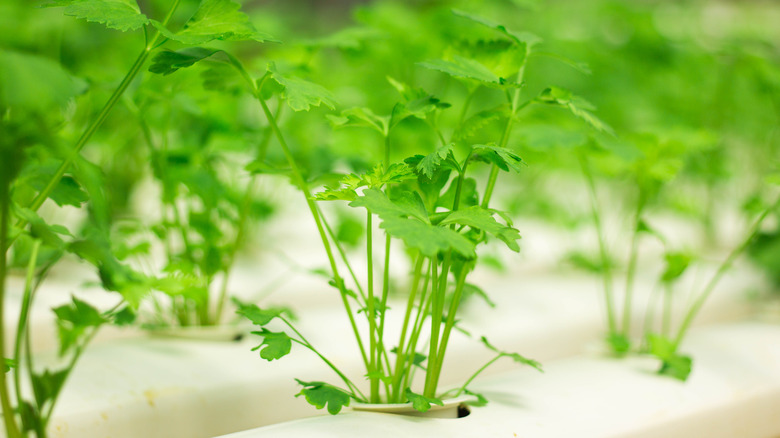20 Edible Plants You Can Grow In An Outdoor Hydroponic Garden
Hydroponics, put simply, is the process of growing fruits, vegetables, herbs, and other plants without soil. The setup is relatively straightforward; most hydroponic gardens need only a water-culture system, container, nutrient system, and plants in the form of seedlings or seeds, per the University of Nevada, Reno. Many larger hydroponic systems have been set up by universities aiming to research this relatively under-tested growing method and by agricultural companies who intend to grow seasonal crops year-round. Despite being less researched than other types of gardening, there's still plenty of information out there about how to start hydroponic gardening from your own backyard. Still, you should expect to go through some amount of trial and error.
Though hydroponic gardening is a great solution for gardening year-round indoors, it is used outdoors to help gardeners grow healthier crops with higher yields. Your outdoor hydroponic system can be as large or as small as you like. Some people, like On The Grow Farms on TikTok, have extremely simple setups made out of little more than a bucket and some net pots. Keep in mind that not all plants are suitable for growing hydroponically. You must research those you wish to grow in order to figure out whether they'll thrive if you plant them this way and what they'll need when you do. To help you out with this, we've compiled 20 edible plants that you can grow with ease in your outdoor hydroponic garden.
1. Pumpkin
Pumpkins (Cucurbita maxima) can be easily grown in a hydroponic system, but you would not want to do so indoors. This is because the plant spreads widely, sometimes up to 12 feet, advises Missouri Botanical Garden. In an outdoor hydroponic setup, pumpkins can receive the water and nutrients needed to survive while also receiving natural sunlight and cooler fall temperatures.
Bloom Season: Summer
USDA Growing Zone: 2 to 11
Growing Conditions: Full sun
Size: 9 to 18 inches tall and 10 to 12 feet wide
2. Chives
Chives (Allium schoenoprasum) thrive in milder climates, but they can be grown almost anywhere with the right kind of care. University of Wisconsin-Madison notes that this plant is characterized by purple flowers and upright, hollow leaves that are bright green. These edible leaves are similar in flavor to onion and garlic which share the same genus as chives.
Bloom Season: Spring and summer
USDA Growing Zone: 3 to 9
Growing Conditions: Full sun
Size: 12 to 18 inches tall and 12 to 18 inches wide
3. Zucchini
Zucchini plants (Cucurbita pepo) can benefit from being grown hydroponically outdoors because they grow aggressively in the garden when provided with plenty of sunlight and water, as per North Carolina State Extension. In a traditional garden setup, you have to carefully watch your zucchini to make sure they don't overtake smaller plants, but growing them hydroponically will help solve this problem by containing them.
Bloom Season: Summer
USDA Growing Zone: 3 to 11
Growing Conditions: Full sun
Size: 1 to 2 feet tall and 2 to 3 feet wide
4. Celery
Celery (Apium graveolens) is an edible plant that prefers colder climates. It's best grown outdoors where it can receive direct sunlight without becoming too hot. Missouri Botanical Garden says that the celery plant is normally harvested in the fall before the first frost in the winter. The stems can be easily removed with sterile shears and eaten raw with dipping sauce or cooked into a stew.
Bloom Season: Seasonal bloomer
USDA Growing Zone: 3 to 6
Growing Conditions: Full sun
Size: 24 to 30 inches tall and 12 to 18 inches wide
5. Broccoli
Broccoli (Brassica oleracea) is great for growing in hydroponic gardens. The Brassica family of plants, notes Maximum Yield, is well-suited to hydroponics and has shown lots of potential when grown this way. Even without the extra science, broccoli is a valuable plant in the garden for its low-maintenance needs and delicious cruciferous vegetables.
Bloom Season: Spring to summer
USDA Growing Zone: 6 to 9
Growing Conditions: Full sun to partial shade
Size: 10 to 24 inches tall and 12 to 24 inches wide
6. Basil
Herbs such as basil (Ocimum basilicum) are best grown outdoors in a companion planting arrangement with other edible plants such as tomatoes, peppers, and herbs like oregano and chives. Grown together, they're easy to harvest at once so you can make a delicious pasta or meat dish with fresh ingredients from your garden. How To Culinary Herb Garden says fast-growing hydroponic basil can be ready to eat in less than a month.
Bloom Season: Summer
USDA Growing Zone: 2 to 11
Growing Conditions: Full sun
Size: 18 to 24 inches tall and up to 2 feet wide
7. Turnip
Turnips (Brassica rapa subsp. rapifera) belong to the same genus as broccoli, and they are just as simple to grow. According to UIC Heritage Garden, they're packed with nutrients and they have a high calcium content. Humans have a long history of eating the roots and leaves in a variety of ways by sautéing, roasting, or boiling for the best taste.
Bloom Season: Summer
USDA Growing Zone: 3 to 10
Growing Conditions: Full sun to partial shade
Size: 12 to 24 inches tall and 6 inches wide
8. Brussels sprouts
Brussels sprouts (Brassica oleracea, Gemmifera group) have received a bad wrap. Yet, they're densely packed with important vitamins, and they can taste great if they're prepared correctly. The first step in creating mouth-watering Brussels sprouts is to raise them carefully. As explained by Missouri Botanical Garden, the plant must be harvested after the first frost for the best flavor.
Bloom season: Rarely flowers before harvest
USDA Growing Zone: 2 to 11
Growing Conditions: Full sun
Size: 2 to 3 feet tall and 1 to 2 feet long
9. Paprika peppers
Paprika peppers (Capsicum annuum L.) are well-suited to growing in the U.S., particularly in warmer regions where they can be grown outdoors with little intervention. There are several different varieties of paprika peppers and each of them has a slightly different flavor which stays around even after the pepper has been dehydrated and powdered, notes University of Florida.
Bloom Season: Spring
USDA Growing Zone: 6 to 11
Growing Conditions: Full sun
Size: 2 to 3 feet tall
10. Lemon tree
Yes, even fruit trees can be grown hydroponically. Lemon trees (Citrus limon) thrive in warm climates that provide plenty of direct sunlight as the trees grow continually throughout the year. Growing lemon trees hydroponically makes sense when you consider how they are grown normally. Purdue University says most groves use sand or silty clay loam, which are both known for their high water-holding capacity.
Bloom Season: Spring
USDA Growing Zone: 8 to 11
Growing Conditions: Full sun
Size: 10 to 20 feet tall
11. Kale
Kale (Brassica oleracea var. sabellica) is a perfect choice when growing vegetables hydroponically. This superfood can be pricey at the grocery store, so it pays for itself in your garden. Another benefit of growing kale at home is that you can decide when you're ready to harvest. Love the Garden recommends removing the leaves when they're still young and tender for the best taste.
Bloom Season: Summer
USDA Growing Zone: 7 to 10
Growing Conditions: Full sun to partial shade
Size: 30 inches tall and 20 inches wide
12. Mint
Mint (Mentha spp.) is among the most obvious herb choices for an outdoor hydroponic garden because of its aggressive growth, need for direct sunlight, and ability to withstand colder climates. This Mediterranean herb, as noted by Utah State University, is a valuable addition to any type of garden setup because it is adaptable, packed with vitamins, and a versatile ingredient in the kitchen.
Bloom Season: Summer to fall
USDA Growing Zone: 3 to 8
Growing Conditions: Full sun to partial shade
Size: Up to 3 feet tall
13. Avocado tree
If you love to hoard your avocado pits as much as Alexander Christian on TikTok, we have a solution for you. Avocado trees (Persea americana) will grow hydroponically both indoors and out. However, because of their tendency to grow tall, you should transfer them outside as soon as you can, advises University of Florida.
Bloom Season: Winter and spring
USDA Growing Zone: 9 to 11
Growing Conditions: Full sun
Size: 30 to 40 feet tall and 25 to 35 feet wide
14. Watercress
Watercress (Nasturtium officinale) is a beloved microgreen that you might have eaten raw on salads or cooked in a stir fry. Per Minnesota Wildflowers, they are often found growing in shallow water along streams and ponds or in muddy banks, seeps, and wet ditches. Because of their love for wet growing conditions, these nutrient-packed plants grow easily in hydroponic gardens with very little help.
Bloom Season: Spring
USDA Growing Zone: 6 to 9
Growing Conditions: Full sun to partial shade
Size: 4 to 15 inches tall, spreads rapidly
15. Ghost pepper
Ghost peppers (Capsicum chinense) are some of the spiciest peppers in existence. They can be grown as annuals or perennials in hydroponic gardens. They prefer warm temperatures, but are adaptable to a range of conditions when it comes to growing mediums and care schedules. Though ghost peppers are drought-tolerant, North Carolina State Extension says regular access to water will benefit the quality of the fruit.
Bloom Season: Summer
USDA Growing Zone: 10 and 11
Growing Conditions: Full sun
Size: 12 to 30 inches tall and 12 to 24 inches wide
16. Blueberry
Highbush blueberry bushes (Vaccinium corymbosum) grow very tall compared to the other plants in this collection, which is why they are recommended for outdoor hydroponic gardens instead of indoor setups. According to Jersey-Friendly Yards, another reason this type of blueberry bush is great outdoors is because it provides nectar for pollinators such as bees and birds.
Bloom Season: Late spring to early summer
USDA Growing Zone: 4 to 7
Growing Conditions: Full sun to partial shade
Size: 6 to 12 feet tall and 8 to 12 feet wide
17. Strawberry
Strawberries (Fragaria × ananassa) grow on a flowering perennial plant frequently referred to as a bush despite being a ground cover (via North Carolina State Extension). The flowers appear in the spring and give way to the sweet red fruit in the summer. These can be finicky plants because they require a lot of water to survive. Grown hydroponically, you may actually have better results than you would otherwise.
Bloom Season: Spring
USDA Growing Zone: 5 to 9
Growing Conditions: Full sun to partial shade
Size: 6 to 12 inches tall and 1 to 2 feet wide
18. Radish
Radishes (Raphanus sativus) have a long history of use by humans around the world. This vegetable, which has edible roots and leaves, is supposedly native to southern Asia, but it is grown in many different countries and regions today, states Missouri Botanical Garden. Because radishes are yet another member of the hydroponic-loving Brassica family, it's a safe assumption that yours will do well in water, too.
Bloom Season: Spring
USDA Growing Zone: 2 to 11
Growing Conditions: Full sun
Size: 2 to 3 feet tall and 1 to 2 feet wide
19. Scallions
Scallions (Allium fistulosum) are frequently used as a substitute for chives in a pinch. This vegetable is characterized by tall, hollow leaves and a small bulb that tastes very similar to an onion, explains Missouri Botanical Garden. Scallions are tolerant plants that can be grown in a range of environments and mediums with minimal maintenance.
Bloom Season: Spring
USDA Growing Zone: 6 to 9
Growing Conditions: Full sun
Size: 1 to 3 feet tall and 1 to 2 feet wide
20. Cilantro
The cilantro plant (Coriandrum sativum) provides us with its delicious leaves as well as coriander seeds which are typically crushed and used in sauces and marinades. Like other plants in this collection, cilantro grows well in cooler climates, according to North Carolina State Extension. In an outdoor hydroponic setup, cilantro benefits from being contained, whereas it tends to become weedy in traditional soil-based gardens.
Bloom Season: Summer
USDA Growing Zone: 2 to 11
Growing Conditions: Full sun to partial shade
Size: 1 to 2 feet tall and wide
